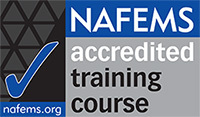| ID | Competence Statement |
| MASco2 | Explain the terms Isotropic, Orthotropic, Anisotropic and Homogeneous. |
| CMPSkn1 | List the various steps in the analysis/simulation process and identify those requiring particular consideration due to the inherent nature of the composite material / structure. |
| CMPSkn2 | Define the meaning of membrane/bending coupling and outline the circumstances in which this can occur. |
| CMPSkn3 | List the various failure criteria available in any system used. |
| CMPSkn4 | Identify the laminated elements available in any system used, highlighting any developer preferences. |
| CMPSco1 | Discuss the sources of approximation inherent in finite element analysis of composite materials and structures. |
| CMPSco2 | Describe the approximate post-processing method used with some elements to obtain inter-ply shear and normal stresses. |
| CMPSco3 | Discuss approximations relating to fibre direction in curved shell models. |
| CMPSco4 | Explain how manufacturing methods can lead to fibre direction and volume fraction variations from the "as-specified" or "ideal". |
| CMPSco5 | Discuss the difficulties that can arise in using symmetry techniques and plane stress/strain assumptions. |
| CMPSco6 | Discuss the various failure mechanisms in composite materials. |
| CMPSco7 | Discuss the difficulties inherent in conducting analyses involving damage progression. |
| CMPSco9 | Outline how element stiffness matrices are evaluated for laminated elements. |
| CMPSco10 | Explain the term free edge effect. |
| CMPSco13 | Explain the terms cross-ply, unidirectional, unsymmetric and balanced. |
| CMPSco14 | Discuss the ABD matrix. |
| CMPSco15 | Explain the terms drape and bias. |
| CMPSco16 | Explain the terms weft and weave. |
| CMPSco18 | Explain the terms gel coat and pre-preg. |
| CMPSco19 | Discuss the general roles of fibre and matrix in a composite. |
| CMPSco21 | Discuss scenarios where a Representative Volume Element modelling approach would be appropriate. |
| CMPSco22 | Discuss some possible analysis consequences of utilising a laminate with an unsymmetrical/anti-symmetric lay-up. |
| CMPSco24 | Contrast the relative significance of transverse shearing effects for composites and isotropic homogeneous materials. |
| CMPSco25 | Explain the term quasi-isotropic and illustrate a laminate specification where this might be a reasonable assumption. |
| CMPSco26 | Explain the purposes of the skins and core in a sandwich construction. |
| CMPSap1 | Complete laminate definitions, using stacking notation, for a range of materials and lay-ups. |
| CMPSap2 | Illustrate the approximate nature of finite element analysis, through examples chosen from your industry sector or branch of engineering. |
| CMPSap3 | Illustrate situations where use of an equivalent orthotropic idealisation may be appropriate. |
| CMPSap4 | Use laminated shells and bricks effectively in small displacement, linear elastic FEA. |
| CMPSap5 | Use sandwich elements effectively in small displacement, linear elastic FEA. |
| CMPSap6 | Use laminated shells and bricks effectively in nonlinear FEA. |
| CMPSan3 | Employ draping software, where applicable. |
| CMPSan4 | Employ Laminate Analysis Software as a complimentary tool where appropriate. |
| CMPSsy3 | Plan a series of simple benchmarks in support of a composite analysis. |
| CMPSev1 | Select appropriate idealisations for typical industry components/structures, which are consistent with the objectives of the analyses. |
| CMPSev2 | Specify appropriate failure criteria for a range of analyses. |
| MSAkn1 | Define Multiscale Analysis. |
| MSAkn7 | Define and list the classical approaches to multi-scale analysis. |
| MSAco3 | EComposite FEAplain continuum theory and why continuum methods cannot be used at the atomistic scale. |
| MSAco12 | Describe the trends in hardware and software and how these will impact on current multi-scale analysis procedures. |



